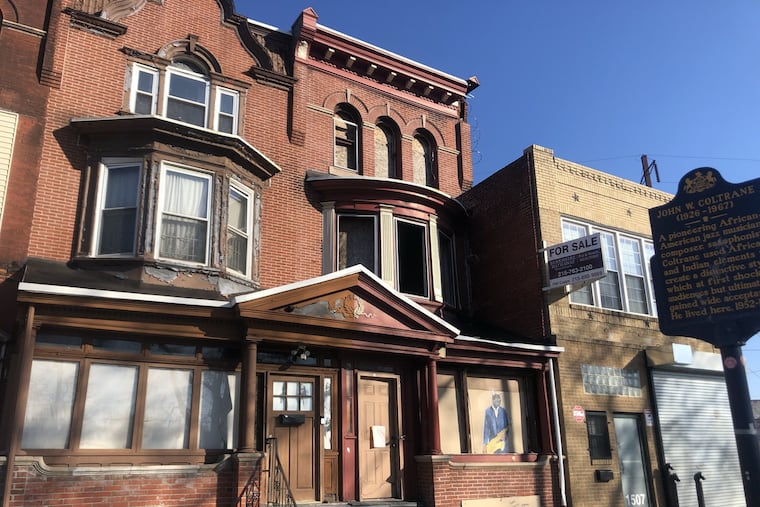Fires and demolitions threaten Strawberry Mansion block where historic John Coltrane house struggles for survival | Inga Saffron
The handsome, late 19th-century home where the jazz great composed his most groundbreaking works could be left standing all by itself.

For nearly 15 years, the historic Strawberry Mansion house where jazz great John Coltrane composed his most groundbreaking music has been hanging on by a thread. Despite being designated a national landmark and listed on the city’s historic register, it has been left in such disrepair that jazz historian and preservationist Faye Anderson urged Preservation Pennsylvania in 2020 to include it on its “at risk” list.
The Coltrane house has managed to survive despite that dubious distinction, but the remainder of the handsome, late 19th-century rowhouses on North 33rd Street might not be around much longer. Two adjacent houses on the north side, which have both sat vacant for years, received “make safe” citations from the city after suffering fires in January. Now the house on the south side of Coltrane’s home, 1509 N. 33rd St., has been sold and the new owner is seeking a demolition permit from the city.
Although that house is not listed on the city’s historic register, preservationists believe its loss could seriously compromise the integrity of one of the most significant Black history sites in Philadelphia. Coltrane, a jazz saxophone player and composer, lived at 1511 N. 33rd St. for most of the 1950s, during one of the most creative periods in his life, a time when he experienced the spiritual awakening that allowed him to overcome a struggle with addiction and produce the classic album Giant Steps.
After Coltrane’s death in 1967, his house and its companion at 1509 were acquired by the musician’s beloved cousin Mary Lyerly Alexander, who had inspired the 1960 composition “Cousin Mary.” She became the keeper of Coltrane’s legacy and founded the John Coltrane Cultural Society. The music of Ravi Coltrane, Bootsie Barnes, Odean Pope and other jazz luminaries could often be heard wafting from the combined backyards of the two houses. A drawing of a saxophone-wielding cat still hangs in the window of 1509 N. 33rd.
While the demolition request for 1509 must still be approved by the Historical Commission because it shares a party wall with Coltrane’s house, it’s rare for such requests to be rejected.
Because the pandemic has delayed updates to city property records, it’s not clear who is now the legal owner of 1509. But the recent sale, and the sudden request for a demolition permit, has taken local preservationists by surprise. “We never imagined 1509 would be considered expendable,” said Paul Steinke, the head of the Preservation Alliance.
Until his group learned of the proposed demolition this week, things seemed to be looking up for the Coltrane house. With funding and support from Community Design Collaborative, Strawberry Mansion’s local development organization just completed a feasibility study for a new cultural center. That plan suggested that the Coltrane house could be combined with three others on the block.
No sooner was that work done, then fire struck two of the houses that would have been part of the project — 1513 and 1515 N. 33rd Street. Both are owned by city agencies.
Steinke said he remains optimistic that the pair can be saved, even though the windows on the upper stories have been left open to the elements by their public owners.
In many ways, the situation at the Coltrane house resembles what has been happening on Christian Street in Graduate Hospital, a once-prosperous Black neighborhood with many large Victorian homes. One of the finest stretches, known as Black Doctors’ Row, has been hit with a series of tear-downs by developers seeking to replace the homes with small apartment buildings. The block was home to several prominent Black figures, yet only the house of architect Julian Abele is listed for protection on the Historic Register.
That’s typical. Historic preservation has tended to focus on individual works of architecture, rather than places where important people lived or major cultural events occurred. Black sites are notoriously underrepresented on the historic register.
As development has accelerated in Philadelphia, the city’s rich Black history has become especially vulnerable. Like Graduate Hospital, Strawberry Mansion is experiencing intense developer interest, especially the stately Victorians that line 33rd Street and face directly onto East Fairmount Park.
In 2019, a vacant lot at 1501-05 N. 33rd sold for $650,000, and now 1507 is for sale. It’s possible the entity that bought 1509 may seek to combine all three properties into a large development site.
Even if 1509 can’t be saved, any development on the block should respect the presence of Coltrane’s house, argued Tonnetta Graham, president of the Strawberry Mansion Community Development Corp. Her group recently succeeded in creating a special zoning district to give residents more oversight over new construction. That district does not include the 1500 block of 33rd Street, however.
Anderson, the jazz historian and preservationist, said she is deeply troubled by the city’s failures to slap neglectful owners with code violations to protect buildings that shaped the city’s Black history.
“Why is this being allowed to happen?” she demanded. “John Coltrane belongs to the whole world,” not just Philadelphia.